Archive for March, 2015
Juz Kitson in the Redlands Konica Minolta Art Prize at the National Art School: “It’s not about the shock factor, and never has been”
Mar 30th
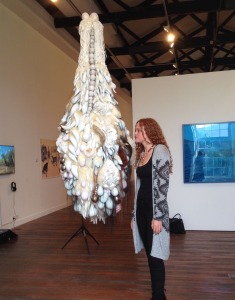 Juz Kitson was selected for the Redlands Konica Minolta Art Prize, on now at the National Art School (until May 23, 2015).
Juz Kitson was selected for the Redlands Konica Minolta Art Prize, on now at the National Art School (until May 23, 2015).
Kitson’s work, titled Something Sacred, is a mad bouquet of strange, seemingly half-formed, animalistic objects. It is suspended from the ceiling and hangs clear of the floor, globular and vaguely confronting. Artist Sophie Cape selected Kitson to show with her in the Redlands Prize, which was curated by artist Tim Johnson.
Kitson was selected to exhibit in the 2013 Primavera exhibition of young artists at the Museum of Contemporary Art Australia.
She grew up in Sydney but lives in the Yarramalong Valley.
Here’s my interview with Juz Kitson:
Elizabeth Fortescue: Sophie Cape selected you as the artist she wanted to show with. I couldn’t imagine two more different artists.
Juz Kitson: Well, that’s the thing. When Soph approached me it was at the beginning of the year and we’ve known each other for about six years. We studied together at the NAS but about a year apart. Our work is very different aesthetically, but we both have this burning desire to create and to challenge our physical being in the type of work we do. We both work in the Australian landscape. The constant collection of bones and using the environment to not only physically inspire the work but also taking resources from the immediate environment. For me it’s important. I spend a lot of time in the central west like Hill End and Broken Hill, physically going out and collecting road kill and taking different animal carcasses back to my property on the Central Coast, putting it on to the ants’ nest and letting the ants eat away at the flesh and letting them be weathered by the extremes of summer and winter. In terms of that we share a lot in common, but the aesthetic is very different.
You also share a Chinese connection.
I think she once did a Chinese residency. I have a studio in China and I’ve been working there for four years and developing my own practice within a traditional porcelain city which has been producing for over 2000 years.
That’s incredible.
It’s phenomenal, working alongside artisans. Facilities, mould making, slip casting, PVD (physical vapour deposition) which is a form of chroming, different techniques that are just inaccessible to me in Australia. So I create the foundation of the works while I’m in China.
It’s amazing I’m back five years after graduating at the NAS. NAS was a huge influence in that because they gave me a residency in partnership with Tsinghua University. I went over and spent three months working in art and design (department) of Tsinghua. And inevitably things just evolve and happen. You’ll meet a curator and a week later I’m having an exhibition at 798 art district.
(Kitson was also influenced by the Chinese performance artist Lin Tianmiao.)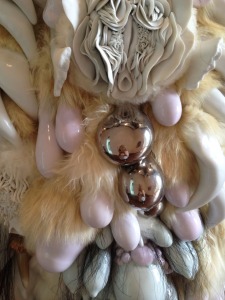
I got in touch with her and asked to be a studio assistant. She let me live with her in her home on the outskirts of Beijing. I lived upstairs and worked in her factory with 25 other female artists, no English, 11 hours a day, seven days. Towards the end she was quite interested in what I was doing and said I needed to go to the ancient porcelain city, Jingdezhen.
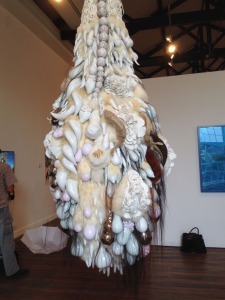 (Kitson first went to Jingdezhen in 2012.)
(Kitson first went to Jingdezhen in 2012.)
It was inevitable that I end up there. I spend half the year there. I can’t get enough of it.
Can you talk about Something Sacred?
This piece was specifically made for the Redlands. I wanted a sense of it being a still moment, that it is going to start breathing. Or bite you or pull you in. By taking something like the horns and road kill, lifeless and inanimate, but to give it new life. And there is a sexual connotation to a lot of the pieces. This one’s quite subtle in terms of the previous work I’ve made. it’s not about in terms of shocking. I want the work to quietly provoke, and people to be drawn to it, or inspired but also repulsed. But quietly. It’s not about the shock factor, and never has been.
Nature has always been a huge influence. I remember as a child always collecting leaves and sticks and constructing pieces out of that. There’s always been an absurd, obscure fascination with even insects.
David Walsh of MONA bought your work?
In 2009 I was half way through the finished installation for my honours project and Emerald Fitzgerald invited David Walsh to come by my studio unexpectedly. He walked into the space and saw the work unfinished. Within four minutes he said ‘how much?’. That was really the pivotal moment.
You were censored in Art Dubai?
They took down nine objects out of 68 objects. Initially I thought it was the form being sexually suggestive, but it was the hair being classed as erotic.
Elizabeth Fortescue, March 30, 2015
John Olsen in painterly conversation with Arthur Streeton at Mosman Art Gallery
Mar 20th
Sydney Harbour, by Arthur Streeton, 1895
It was wonderful to see John Olsen, one of Australia’s oldest living masters, on top of his form at the Mosman Art Gallery this week.
Olsen had made the special trip from his Southern Highlands home to present his painting, titled The Rolling Sea and That Streeton Painting, 2014, as his gift to the gallery.
Exactly why Olsen made this generous gesture, or even created The Rolling Sea in the first place, dates to 2012 when Sydney benefactor Neil Balnaves gave 16 valuable Australian Impressionist paintings to the Mosman gallery.
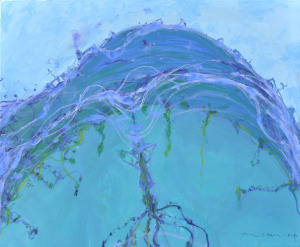
The Rolling Sea and That Streeton Painting, by John Olsen
Olsen had been invited to the celebration surrounding the Balnaves gift, and immediately fell in love with the painting reproduced on the invitation he had received in the mail.
The painting was Sydney Harbour, 1895, by the great Arthur Streeton.
Here are Olsen’s delightful comments yesterday when he walked into the Mosman Art Gallery and saw The Rolling Sea hanging next to Streeton’s Sydney Harbour:
“That’s delicious! It’s almost edible!”, Olsen exclaimed at the first glance of his picture.
“Oh, that’s lovely. I’m so pleased.”
And then he was off, speaking off the cuff in his charming way, telling assembled media all about the picture with barely a prompt from any of us.
“Have you ever travelled on the Manly ferry? And you get to Balmoral way, and it’s getting near the Heads, and it’s been very rough weather and the Manly ferry ploughs into the sea, and it’s very swirly.
“And you see the difference between the two pictures of course. Streeton’s is very very special. It’s 1895 when Streeton first came to Sydney from Melbourne and he’s in great form. Somehow Sydney rejuvenated him, dare I say after Melbourne. And so he did marvellous pictures of the Hawkesbury River, fabulous pictures, (like) Still Glides the Stream, and he took a vantage point there which still exists today. It’s just something that happens to creative people; they can hit their top and everything they do is bloody marvellous. The point being is that whilst they’re blessed, they don’t know. There’s this area of not knowing. And this is a divine picture. When I first saw it I was completely taken by it. I sent a reproduction of it to Clive James, who has very serious illness, leukemia, and he lives in Cambridge and he’d love to come to Australia and he can’t, and he said ‘I like that picture so much that I’ve put it on my bedroom side table’.
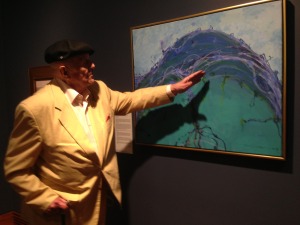
John Olsen at the Mosman Art Gallery, March 2015
“So there it is, and you see it’s just so important and the ferry is just meeting that slight tidal movement at sea and in between there’s a most interesting thing, there’s a big clipper coming in, and there is the modern ship, a steam ship, but they’re still using clippers, it’s 1895.
“Over there is Vaucluse – no houses there! It’s just fantastic. And this lovely touch of the smoke and everything about it is a state of grace. Somehow it’s a blessed kiss that’s taken place. And the sailing boat. But this is another very revolutionary thing. He can see that the best way to do the harbour is to increase by elongation, and furthermore it’s a picture that breaks the chains of us being a colony; it’s completely democratic. Fantastic! It’s such an important picture, and I don’t think Mr Balnaves knew how good it was until I told him. So here it is in the gallery, the right place for it, and it’s in great condition. Later on, have a close look. It’s not mainly blue, there are little touches of violet in it. And the sailing ships are like punctuation marks. And it’s playing again the long, long land mass here. It’s beautiful. And the Heads are again so beautifully painted. It’s a little masterpiece! People should just come, which is the best way to see pictures in the Louvre, just come to watch one picture and hopefully two (indicating his own picture next to the Streeton).
“Whilst Streeton’s picture is planular, this picture (The Rolling Sea) is what I would describe as being in the all-at-once world. Meaning that it’s below the water; it’s the movement of the water, and then the slow sort of turning of the heave of wave. It demonstrates how we in the 20th/21st century view things; that we just don’t really say what I’m looking at is the fact; it’s what lies around it and what surrounds it. And so in consequence this is a kind of reinterpretation. The basic tonality really remains the same, which is what Sydney Harbour is. How luck we are to have the harbour! It’s there to be enjoyed, and I’m very moved that it should be with Streeton. What I’m able to say is that 1895 is a divine period. In 1897 Streeton left Australia hoping to do well in London. He never succeeded. He was sort of there but not there. And he came back, and that innocence had gone. I’m sure you understand the fragility of creativity, and the point of it is the creator himself doesn’t know he has it.

Did you have a copy of the Streeton in the studio while you were painting yours?
Yes, I did, but you see there is the challenge, that it’s no good just following like the pattern of Streeton, even though you can obviously see how much I admired the picture. You have to say, ‘close your eyes. What do I feel?’ And it went back to when we were students at Julian Ahston’s art school and we used to love to go on the ferry when it was rough weather in winter. And we used to love to be not in the cabin but in the front part of the boat, which was a very dangerous thing at the time because the sea often runs over the front of the ferry. And there it was going up and down, and I noticed the ferry in the Streeton picture, of how it was like in that kind of swell is the word, and I thought, ‘now I’ve had that experience, I think I should travel with that’.
Do you have in your mind’s eye exactly where your picture is situated in the Harbour?
Oh well it’s round about the same point as that (the Streeton), slightly towards the Heads.
Your painting is such a generous gift. Why did you do it?
When in love you have no defences!
I think if you live in Sydney the harbour stains your sensibility. There’s something very special about it. It’s the air, and somehow the feeling of belonging to Sydney which is quite different to being a visitor.
Elizabeth Fortescue, March 20, 2015
No more squashed balaclavas: Will Coles is leaving Sydney
Mar 5th
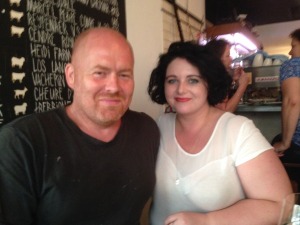
Will Coles and his wife Tiffany Payne-Coles
Will Coles, one of Sydney’s most dedicated art mavericks, is leaving town to live in Spain. All I can say is, “bugger”.
Coles is known to any of you who have ever stumbled across one of his strange and enigmatic concrete sculptures that are stuck down firmly on Sydney’s streets. Squashed balaclavas and drink cans, TV remotes and mobile phones, the small invaders have appeared overnight in shady laneways and odd little parks all over the place. There used to be a squished tetra pack near Royal Prince Alfred Hospital. It was so real I actually reached down to give it a poke. Sure enough, it wasn’t budging. Will Coles had been there, no doubt in the dead of night.
I was lucky to interview Coles a good half-dozen times as I wrote about his exploits and exhibitions for the Daily Telegraph. He also invited me to write a short piece for a brochure on his work.
“Will Coles began exhibiting his sculptures in the back streets of inner suburban Sydney in about 2007, in places where they were pretty much tripped over rather than deliberately sought out for viewing,” I wrote. “Uninvited, raw and unapologetic, they quickly became part of the inner western vibe.”
Coles’ work was taken up by Brenda May Gallery, then Art Equity gallery in Sydney, and he has now had numerous shows. He has also been exhibited in the Holy Grail of Sydney sculpture, Sculpture by the Sea. His appearance there was with a large rendition of those fish-shaped soy sauce containers you get from takeaway shops. But that was many years after he had been an unofficial entrant to Sculpture by the Sea, sneaking into the site under cover of dark to dump his concrete television sets among the invited, sanctioned entries.
Coles’ very witty work, Memorial To The Unknown Armchair General, was exhibited in Hidden, the exhibition of sculpture at Rookwood cemetery. The work is a comfy lounge chair and poof, with a general’s cap on the seat of the chair. All in concrete, I assume. So, as you see, Coles by now is part of the Sydney art scene and has a large and enthusiastic following.
A couple of weeks ago, I met up with Coles and his wife Tiffany Payne-Coles in an Enmore cafe to talk about their plans for Spain. Coles said it felt weird to be leaving when he’s had such a good year. Not only did he marry Tiffany, he also started getting into regional gallery collections, such as Albury, Bathurst and Goulburn, and was shown in the prestigious McClelland sculpture award. “It was the best show I’ve been in, so I was happy with that,” he said.
I asked if the AGNSW had bought anything of his, but no. “I have left stuff outside there,” Coles said. Dropping his art works outside galleries at night has been part of his modus operandi for years.
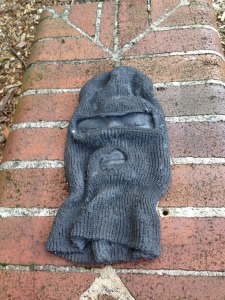
A Coles balaclava
Coles believes galleries such as Tasmania’s MONA and Chippendale’s White Rabbit are the future. He has spent a lot of time at White Rabbit’s beautiful library, a space I only recently discovered myself.
As for Spain, Coles and Tiffany will leave at the end of March and settle in a rural property about two hours drive from Valencia. Coles inherited the property from family. “I’m taking a lot of moulds so as soon as I get there I can start casting,” Coles said.
It looks like Valencia had better start looking out for Coles’ stick-down sculptures, because he aims to continue this habit in Spain.
Coles is excited about living near Barcelona which he describes as a hub for street art. And he’s thrilled to be moving to near Valencia, where amazing street art is everywhere but “no one rates it”.
I was always interested in the fact that Coles’ grandfather was the famous British sculptor Norman Sillman. Coles would consult his grandfather over intractable sculptural problems. I was sad to learn from Coles that Sillman passed away in 2013.
Coles plans to keep exhibiting in Sydney at Art Equity and also at M.Contemporary.
I can only wish Coles and Tiffany a very happy future in Valencia. We will miss them.
Elizabeth Fortescue, March 5, 2015
